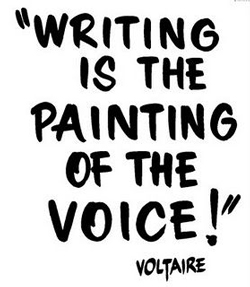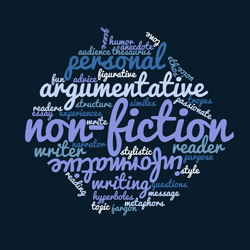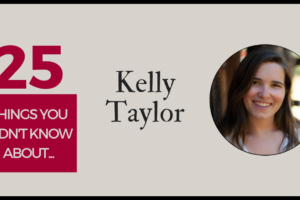 Meghan Miller
Meghan Miller
Student Representative, High Plains Region, 2015-2016
Zeta Psi Chapter
University of Northern Colorado, Greeley, CO
So, you want to write creative non-fiction without boring your readers to death by sounding like a textbook. You are not alone. Creative non-fiction is a fascinating and exciting genre when done properly. It can be informative and fun. Here are a few thoughts to consider while beginning your next non-fiction piece:
What do you want to write about/how do you choose a topic?
 First, what are you passionate about? The answer to this question will lead to writing what you care about and enjoy. Anything you are interested in is worth writing about. Aside from writing about interests there are plenty of other questions and topics that can get your creative juices flowing. Do you have a pet peeve? Is there something you think the world should know? Think about your life experiences; are there any you can relate to a broader theme? Any of these questions will guide you to an exciting topic. Whatever you choose, your topic should have a message or purpose. Avoid writing about something you know nothing about (don’t forget, this is non-fiction).
First, what are you passionate about? The answer to this question will lead to writing what you care about and enjoy. Anything you are interested in is worth writing about. Aside from writing about interests there are plenty of other questions and topics that can get your creative juices flowing. Do you have a pet peeve? Is there something you think the world should know? Think about your life experiences; are there any you can relate to a broader theme? Any of these questions will guide you to an exciting topic. Whatever you choose, your topic should have a message or purpose. Avoid writing about something you know nothing about (don’t forget, this is non-fiction).
What type of creative non-fiction do you want to write?
 Your topic will help determine the type of creative non-fiction you write. Several non-fiction writing styles exist; the most common include personal essay, memoir, argumentative, and persuasive. After you have chosen a topic, you will have to decide what style in which to write. Some styles do not fit with certain topics. For example, you wouldn’t want to write an argumentative essay about your deceased grandma; you likely would choose a memoir.
Your topic will help determine the type of creative non-fiction you write. Several non-fiction writing styles exist; the most common include personal essay, memoir, argumentative, and persuasive. After you have chosen a topic, you will have to decide what style in which to write. Some styles do not fit with certain topics. For example, you wouldn’t want to write an argumentative essay about your deceased grandma; you likely would choose a memoir.
Who is your audience?
Audience is a really important element when writing anything. To whom do you want to appeal? Who do you envision reading your work? It is important to keep the audience in mind as selfish writing likely will disengage the reader. Being aware of your audience will help you manage elements like tone, humor, and jargon.
As a creative non-fiction writer, you must remain a reliable narrator. An audience reading creative non-fiction expects the content to be truthful. Although some truths are stretched in writing for stylistic effect, make sure what you are writing is true and an accurate representation of the topic. Your credibility will be damaged if you fail to do this.
How do you incorporate stylistics into non-fiction writing?
 Now, this is the fun part. Incorporating stylistics into your writing is what keeps your reader from falling asleep. As in any writing, you want to show, not tell. Since you are writing non-fiction, everything you write should be true. However, this should not keep you from using figurative language like hyperboles, metaphors, and similes, because these are the details that separate your writing from textbook writing. These tropes also make your writing unique. Using a personal anecdote is another great way to express your ideas and engage your reader. Make sure everything you use in your writing—down to every word—has a specific purpose.
Now, this is the fun part. Incorporating stylistics into your writing is what keeps your reader from falling asleep. As in any writing, you want to show, not tell. Since you are writing non-fiction, everything you write should be true. However, this should not keep you from using figurative language like hyperboles, metaphors, and similes, because these are the details that separate your writing from textbook writing. These tropes also make your writing unique. Using a personal anecdote is another great way to express your ideas and engage your reader. Make sure everything you use in your writing—down to every word—has a specific purpose.
Vary your sentence structure. Pull out the thesaurus. Let your voice shine through. Just because you are writing non-fiction does not mean you have to leave out all the fun stuff you see in fiction. Happy writing!
What additional advice do you have for creative non-fiction writers?
Submit to The Sigma Tau Delta Rectangle
Follow these helpful tips and submit your creative non-fiction to The Sigma Tau Delta Rectangle. The Rectangle is an annual journal of creative writing that publishes fiction, non-fiction, and poetry. Submissions should not exceed 2,500 words.
The journal is refereed, with jurors from across the country selecting those members to be published. The best writing is chosen, from around 1,000 submissions, for publication. Not only do these publications go to chapters worldwide, but they also honor the best writing in each category, with six awards totaling $2,400. There is also an annual reading at the international convention by any of the published writers in attendance. Additionally, 2017 marks the first year the Sigma Tau Delta journals will be cataloged by the Library of Congress.
The submission deadline for the 2017 journals is Monday, May 9, 2016, 11:59 p.m. CDT (Central Daylight Time).
View: Submission Guidelines





Thanks, Meghan, for the reminder to submit to and support the Rectangle and Review. Good writing tips!